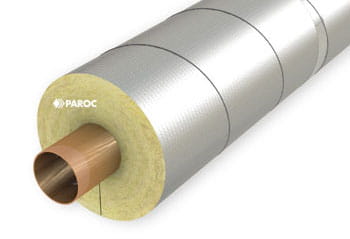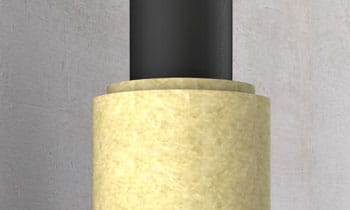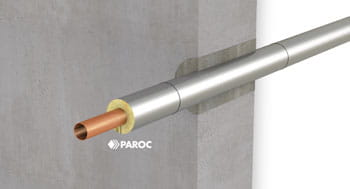As any heat loss from hot water pipes and heating water pipes represents preventable energy loss, you should use effective thermal insulation. Boilers heat water to the correct temperature, after which it is transported in pipes. You need thermal insulation to keep the water at the right temperature until it reaches its destination.
If the temperature of warm water drops too much, there is an increased risk of spreading diseases (e.g. Pontiac fever or Legionnaires' disease) via the warm water. These bacteria thrive in temperatures between 25–45°C, with an optimum at 35°C. Reduce this risk with proper insulation and thus prevent the water from reaching this critical temperature.
Use the Paroc's calculation program PAROC Calculus to find the correct insulation thickness and solution to match your needs.
 |
 |
| Insulating Hvac pipe elbows is easy with pre-fabricated insulation components PAROC Hvac Bend AluCoat T. |
Paroc recommends aluminium foil faced PAROC Hvac products
for HVAC pipes. |
Protect cold water and comfort cooling pipes with thermal insulation and insulation against condensation. Thermal insulation prevents the transfer of heat from the surrounding environment to the pipes. If drinking water in cold pipes becomes warm, it can give rise to bacterial growth within the water. Sufficient thermal insulation ensures that the water in cold water pipes stays cold while, on the other hand, prevents them from freezing.
Insulation also prevents condensation. Warm air contains moisture that condenses when it meets a cold surface. Insulate the surface so that the outer surface temperature of the insulation becomes higher than the dew point temperature of the surrounding air.
When insulating against condensation, it is important that insulation ends and all joints between pipe sections are well taped (see the installation instructions). Over time, condensation can cause damage to pipes, reducing their service life. Condensation water can cause damage and discoloration to ceilings and floors. In the worst case, it can cause mould growth to adjacent constructions.
 |
 |
Insulating Hvac pipe elbows is easy with pre-fabricated
insulation components PAROC Hvac Bend AluCoat T. |
Paroc recommends aluminium foil faced PAROC Hvac products for HVAC pipes. |
Insulate drainpipes and wastewater pipes inside buildings against condensation and, depending on local specifications, also insulate for fire and sound in certain areas.
 |
For sound reduction of drainpipes and waste water pipes Paroc recommends to use PAROC Pro Section 100 or PAROC Pro Wired Mat 100.
|
Please ask for more information about Paroc’s solutions for pipes and pipe penetrations from your local Paroc representative.
Pipe penetrations occur when pipes pass from one fire area to another, providing a potential channel through which fire could spread in a building. To combat this risk, insulate your pipes with a non-combustible insulation material.
For pipe penetrations Paroc recommends to use non-combustible insulation material.
PAROC stone wool products are non-combustible and provide excellent fire protection for pipe penetrations. |
 |
The requirements and solutions for pipes vary from country to country, so please ask for more information about Paroc’s solutions for pipes and pipe penetrations from your local Paroc representative.